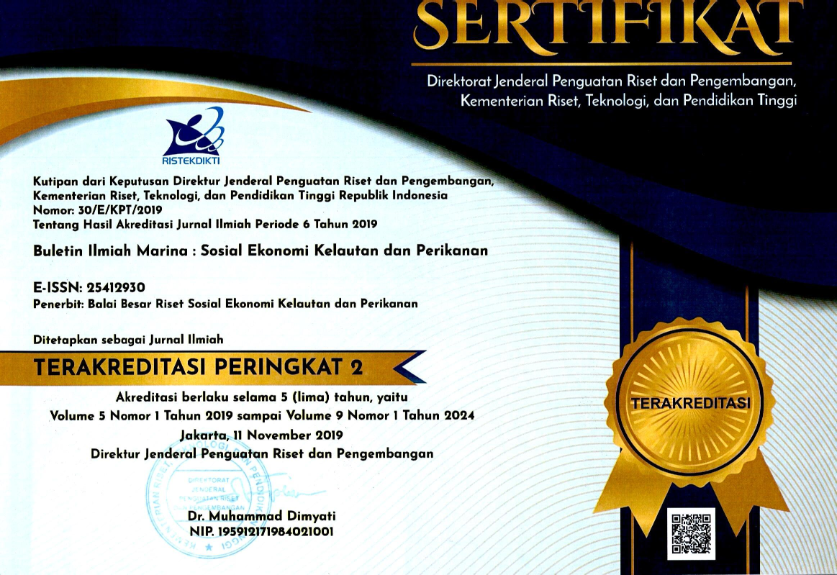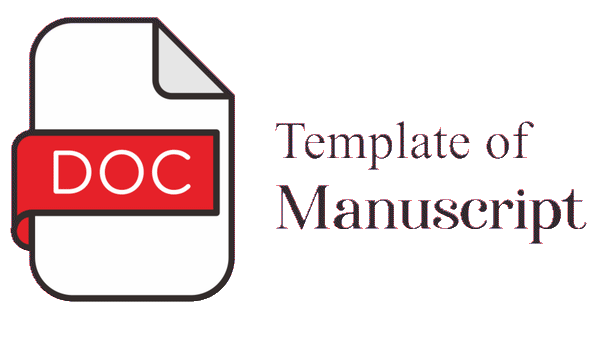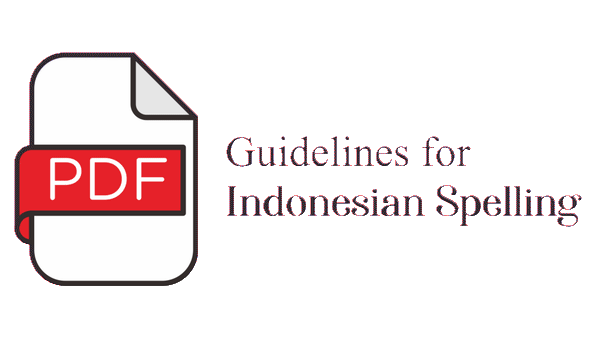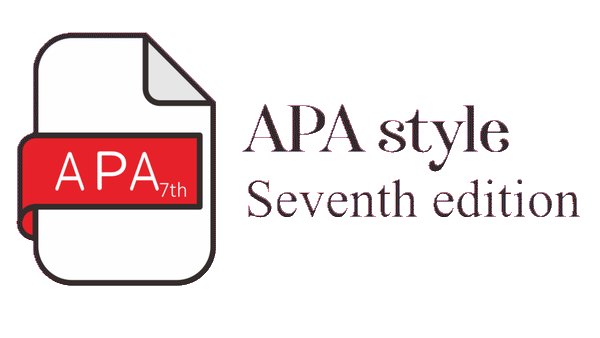PENGARUH MANAJEMEN RANTAI PASOK TERHADAP PERFORMA USAHA BUDI DAYA UDANG VANAME DI PROVINSI BALI DAN JAWA TIMUR
Abstract
Udang vaname merupakan salah satu komoditas ekspor unggulan Indonesia di pasar internasional. Udang vaname yang diekspor merupakan hasil produksi dari usaha budi daya yang tersebar di berbagai provinsi di Indonesia sehingga dibutuhkan rantai pasok yang optimal untuk mendukung kelancaran usaha budi daya tersebut. Tujuan dari penelitian ini untuk menganalisis pengaruh manajemen rantai pasokan terhadap keunggulan bersaing suatu usaha budi daya udang vaname dan dampak terhadap performa usaha tersebut. Lokasi penelitian adalah Provinsi Jawa Timur dan Bali karena konektivitas yang kuat antara masing-masing pembudi daya di kedua lokasi tersebut. Data yang dikumpulkan diverifikasi kemudian dianalisis menggunakan pendekatan Structural Equation Model (SEM). Hasil dari analisis menemukan bahwa variabel hubungan dengan pemasok dan modal manusia berpengaruh positif terhadap keunggulan bersaing pembudi daya dan juga berpengaruh positif kepada performa usaha budi daya tersebut. Variabel hubungan dengan pelanggan tidak berpengaruh baik terhadap keunggulan bersaing maupun performa usaha. Dari hasil ini diharapkan pemerintah bisa mengintervensi dalam bentuk perbaikan manajemen rantai pasokan udang vaname dengan meningkatkan kompetensi masing-masing anggota rantai pasok sehingga dapat optimal pada posisinya.
Title: The Effect of Supply Chain Management on The Business Performance of Vaname Shrimp Farming in The Province of Bali and East Java
Vaname is one of Indonesia’s leading export commodities in the international market. The exported vaname are the products from aquaculture business which are spread in various provinces in Indonesia, so an optimal supply chain is needed to support this business. The purpose of this study is to analyze supply chain management affects the competitive advantage of a vaname farming business and the impact on the performance of the business. The research sites are East Java and Bali because of the strong connectivity between each farmer in both locations. The collected data is verified and then analyzed using the Structural Equation Model (SEM) approach. The results of the analysis concluded that the relationship between suppliers and human capital variables had a positive effect on the competitive advantage of farmers and also had a positive effect on the performance of the aquaculture business. While the relationship with customer variables do not affect both competitive advantage and business performance. From this result, the government is expected to be able to intervene in the form of improved management of the vaname supply chain by increasing the competence of each member of the supply chain so that it can be optimally positioned.
Keywords
Full Text:
PDFReferences
Adha, W. M. (2017). Integrasi Rantai Pasok terhadap Kinerja dan daya saing kakao. Jurnal Bisnis Darmajaya Vol 03 No 02.
Bakshi, H. C. (2015). Examining intellectual capital and competitive advantage relationship: role of innovation and. International Journal of Bank Marketing.
Banerjee, M. & Mishra, M. (2015). Retail Supply Chain Management Practices in India: A Business Intelligence Perspective. Jurnal of Reatailing and Costumer Sevices, 12
Barney, J. B., dan Hesterley, W. S. (2008), Strategic management and competitive advantage, Upper Saddle River, New Jersey: Pearson Prentice Hall
[BPS] Badan Pusat Statistik Provinsi Bali. (2018). Provinsi Bali dalam Angka 2018. Bali.
[BPS] Badan Pusat Statistik Provinsi Bali. (2019). Produk Domestik Regional Bruto Menurut Lapangan Usaha 2015-2019. Bali
[BPS] Badan Pusat Statistik Provinsi Jawa Timur. (2018). Provinsi Jawa Timur Dalam Angka Tahun 2018. Jawa Timur
Brown, W. J. (2003). Agribusiness Cases in Supply Chain Management. Paper. IFMA Congress.
Cempakasari, D. A., & Yoestini. (2003). Studi Mengenai Pengembangan Hubungan Jangka Panjang Perusahaan Dan Pengecer. Jurnal Sains Pemasaran Indonesia. Vol II, No. 1.
Champion, S. C., & Fearne, A. P. (2001). Supply Chain Management: A First Principles Consideration of Its Application to Wool Marketing. Jurnal Wool Technology of Sheep Breeding Vol. 49 (3). Hal. 222-236.
Deshpande, A. (2012). Supply Chain Management Dimensions, Supply Chain Performance and Organizational Performance: An Integrated Framework. International Journal of Business and Management Vol 7.
[DKP] Dinas Kelautan dan Perikanan Provinsi Bali. (2019). Statistik Perikanan Budidaya Tahun 2019. Bali
[DKP] Dinas Kelautan dan Perikanan Provinsi Jawa Timur. (2018). Statistik Perikanan Budidaya Tahun 2018. Jawa Timur
Ferdinand, A. (2000). Structural Equation Modelling dalam Penelitian Manajemen. Semarang: Penerbit Universitas Diponegoro
Ghozali, I. (2006). Aplikasi Analisis Multivariate dengan Program SPSS. Semarang. Badan Penerbit Undip.
Ghozali, I. (2011). Aplikasi Analisis Multivariate dengan Program IBM SPSS 19 (5 ed.). Semarang: BP Universitas Diponegoro.
Goyal, S. K, & Cardenas-Barron, L. E. (2001). Note on: An Optimal Batch Size for a Production System Operating Under a Just in Time Deivery System. International Journal of Production Economics.
Gunasekaran, A., Patel, C., & Mc Gaughey, R. E. (2004). A framework for supply chain performance measurement. International Journal of Production Economics, Vol 87 (333-347), USA
Hair, J. F., Ringle, C. M., Marko, S. (2011). PLS-SEM: Indeed a Silver Bullet. Journal of Marketing Theory and Practice, vol 19 no 2 (139-151)
Heizer, J., & Render, B. (2005). Management Operasi. Jakarta: Salemba Empat.
Grant, D. B. (2012). Logistics Management. Pearson Education, Harlow UK.
Gunasekaran, A., & Ngai, E. W. T. (2012). The future of operations management: An outlook and analysis’, International Journal of Production Economics 135(2),687–701.
Hassini, E., Surti, C., & Searcy, C. (2012). A literature review and a case study of sustainable supply chains with a focus on metrics’, International Journal of Production Economics In press (0), URL: http://www.sciencedir ect.com/science/article/pii/ S0925527312000576.
Kamukama, N. (2013) ‘Intellectual Capital: Company’s Invisible Source of Competitive Advantage’, International Business Journal, 23(3), pp. 260–283.
Katos, A. V. (2010). The influence of information and communication technologies on enabling trade: across-country investigation, Journal of Information Technology Impact, Vol. 10 No. 1, pp. 15- 24.
Lee, C. W., G. Kwon, I. W., & Severance, D. (2007). Relationship between supply chain performance and degree of linkage among supplier, internal integration, and costumer. 10.
Mentzer, J. T. (2008). Rigor versus relevance: why would we choose only one? Journal of Supply Chain Management 44(2), 72–77.
Pujawan, I. N., & Mahendrawathi, E. R. (2010). Supply Chain Management. Edisi 2. Surabaya: Guna Widya.
Rahadi, D. R. (2012). “Pengaruh Supply Chain Management Terhadap Kinerja Operasional Perusahaan”. Proceeding Seminar Sistem Produksi X.
Rahmasari, L. (2011). Pengaruh Supply Chain Management terhadap Kinerja Perusahaan dan Keunggulan Bersaing (Studi Kasus pada Industri Kreatif di Provinsi Jawa Tengah). Jurnal Ilmiah
Informatika, Vol 2, No. 2
Rai, I. G. A. (2008). Audit Kinerja Pada Sektor Publik: Konsep, Praktik, Studi Kasus. Jakarta: Salemba Empat.
Ramadan, Y. S., & Kusumawardhani, A. (2017). Analisis Pengaruh Manajemen Rantai Pasokan terhadap Performa Bisnis (Studi: Pedagang Grosir Tradisional Makanan dan Minuman Ringan
Tradisional di Kabupaten Banyumas). Diponegoro Journal of Management Volume 6 No 3.
Simchi-Levi, D., Kaminsky, P., & Simchi-Levi, E. (2008). Designing and Managing the Supply Chain. New York: The McGraw-Hill.
Smith, D. A., & Langfield-Smith, K. M. (2004). Structural Equation Modeling in Management Accounting Research: Critical Analysis and Opportunities. Journal of Accounting Literature, 23, 49-86.
Sugiyono. (2013). Metode Penelitian Pendidikan Pendekatan Kuantitatif, Kualitatif, dan R&D. Bandung: Alfabeta.
Tennenhaus, M., Amato, S., & Vinzi, V. E. (2004). A Global Goodness of-Fit Index for PLS Structural Equation Modelling”, Proceedings of The XLII SIS Scientific Meeting, Vol. Contibuting Papers, CLEUP, Padova, pp. 739-742.
Todericiu, R., & Stanit, A. (2015). Intellectual Capital - The Key for Subtainable Competitive Advantage for the SME’s Sector. 6.
Wuwung, S. C. (2013). Manajemen Rantai pasokan Produk Cengkeh pada Desa Wawona Minahasa Selatan. Jurnal EMBA 1 (3): 230-238.
DOI: http://dx.doi.org/10.15578/marina.v6i2.8474
Refbacks
- There are currently no refbacks.
Indexed by:
---------------------------------------------------------------------------------------
Published by
Balai Besar Riset Sosial Ekonomi Kelautan dan Perikanan
in collaboration with
Indonesian Marine and Fisheries Socio-Economics Research Network

This work is licensed under a Creative Commons Attribution-NonCommercial-ShareAlike 4.0 International License.

























